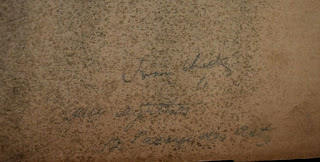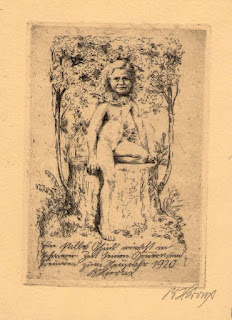Louis Carl Bruno Heroux (1868-1944)
I must admit that since my first print making class at University I have been in love with the artistic ability of early 20th century artists who specialize in the production of original bookplates to put so much information and beauty into the small intaglio footprint of a small zinc plate. That artistic ability is so worthy of high praise. The idea that an artist can cram so much artistic depth of information into such a small amount of space on a zinc plate the size of a page in a book just boggles my mind. I found this small print on eBay Germany and just fell in love with the artist’s unique printmaking ability.
The following biographic information is attributed to Wikipedia:
“Héroux came from a Huguenot family on his father's side family. He was born in Leipzig as the son of the engraver Louis Héroux and his wife Minna, née Zimmermann.[1] He received his artistic training from 1886 to 1892 at the Hochschule für Grafik und Buchkunst Leipzig, where he devoted himself in particular to the study of xylography. The invention of the raster cliché rendered his original wish to work as a wood engraver futile. After a temporary job in the commercial sector, he first earned his living as an illustrator for fashion magazines and humorous magazines.[2]
From 1900, he worked as a freelance graphic artist and was already represented with three works at the International art exhibitions in Dresden the following year.[3] In particular, his etched nude ex libris and the use of the special graphic form of Remarquendrucke contributed to his popularity and reputation. As early as 1903, he was appointed as a teacher at the Royal Academy of Graphic Arts in Leipzig. In 1908, he was awarded the title Professor. From 1900 to 1910, he regularly exhibited his paintings and prints at the Salon des Artistes Français in Paris.[4]
In 1910, he compiled his first 200 graphic works in a catalogue raisonné. The self-published catalogue was published in a one-time edition of 500 copies, 100 of which were provided as a special edition with an etching and the signature of the artist. The successful draughtsman, who was appreciated and supported by contemporaries such as Max Klinger, was extremely productive. Over a period of eight years, for example, he produced 600 illustrations for the three-volume Handatlas of Human Anatomy by the physician Werner Spalteholz (1861-1940), published in Leipzig in 1913, which are regarded as masterpieces of anatomical drawing. Within two years he had also created the illustrations for the Atlas of the Anatomy of the Horse, which was published from 1901. In addition, he published several portfolios with drawings he had made on his travels through Italy and Russia. In 1913, he was the responsible artistic director of the art volume Das Völkerschlachtdenkmal (Weiheschrift 1813-1913), which contained, among other things, his portraits of the mayors of Leipzig.
For many years, Héroux was the chairman of the Leipzig chapter of the Allgemeine Deutsche Kunstgenossenschaft and an honorary member of the Leipziger Künstlerverein. He was also a member of the Leipzig artists' association Leoniden, founded by Edwin Bormann, Georg Bötticher and Arthur von Oettingen, for which he produced numerous graphic works.[6]
Shortly after a large part of his printing plates were destroyed by the air raids on Leipzig on 4 December 1943, the artist died of a severe internal ailment. His ashes were quietly interred.[7]”
————————————————————————————————————————
Here are just a few of his large body of fine works:




















































































